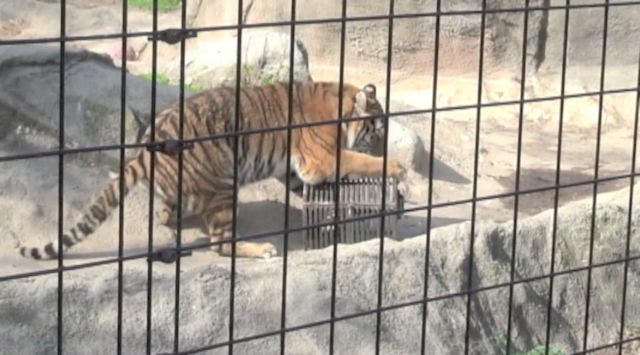Does having a bigger brain relative to the body size make you smarter? This has been the subjected for debate among researchers for many years. Some say that the smartest beings are those who go along well in groups, being social by nature. Though far from being the last word on the matter, a new study that tested the relationship between brain size and problem-solving ability in carnivorous mammals found the animals that didn’t operate in social groups actually performed better than those that did. A general trend was found: those animals with the highest brain/body size ratio were better at solving a problem they had never seen before.
The researchers worked with 140 different zoo carnivores from 39 species, like arctic foxes, polar bears, tigers, spotted hyenas and wolves. The task was simple enough: each animal had 30 minutes to extract food from a metal box, closed with a bolt latch. The box was scaled to the animal’s size and baited with each study animal’s preferred food. For instance, bamboo for red pandas (aww!) and juicy stake for snow leopards.
Overall, 35 percent of the animals successfully solved the problem. Bears were the most successful in completing the task with 70% of individuals opening the box, though the average would have been higher were it not for the southeast Asia’s sun bear. Raccoons did well half of the time, while meerkats and mongooses failed completely — not one individual managed to open the box. Oddly enough, nine animals opened the box but didn’t care to eat the food inside. All for the fame and glory, I guess. Or just leave something for the poor mongooses to eat.
The team factored for dexterity and social behaviour, and found neither made a difference. “If the social brain hypothesis can predict success at solving non-social problems, then we would expect that species that live in larger social groups should be more intelligent,” said Kay Holekamp, an integrative biologist at Michigan State University (MSU), and senior author of the paper. “However, we did not find any support for that prediction in this study.”
The sample size is rather small though. In some cases, only 3 specimens from a species were tested which is far from being revealing. After all, pick three random people out of a crowd to gauge the intelligence of the entire human race and we might be in for a disappointment. The biggest problem I have however is that the researchers presented the same task to a myriad of different species. Each species after all has evolved to occupy a special niche, and in its niche or set of problems it needs to solve each day, it may be the most intelligent. The mongoose might be crap at opening boxes, but it sure does know how to hunt cobras. The idea, of course, is to give a bunch of animals a problem they’ve never seen before and generally see which one is better, then study the brain and body size relationship. In this respect, the findings do indeed suggest, among carnivores at least, that the brain/body ratio does matter.
I’m not convinced yet, though.











